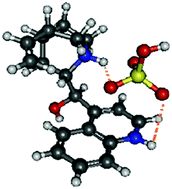The effect of complexation with sulfuric acid on the photo-dissociation of protonated Cinchona alkaloids, namely cinchonidine (Cd), quinine (Qn) and quinidine (Qd), is studied by combining laser spectroscopy with quantum chemical calculations. The protonated complexes are structurally characterized in a room-temperature ion trap by means of infra-red multiple photon dissociation (IRMPD) spectroscopy in the fingerprint and the ν(XH) (X = C, N, O) stretch regions. Comparison with density functional theory calculations including dispersion (DFT-D) unambiguously shows that the complex consists of a doubly protonated Cinchona alkaloid strongly bound to a bisulfate HSO4− anion, which bridges the two protonated sites of the Cinchona alkaloid. UV excitation of the complex does not induce loss of specific photo fragments, in contrast to the protonated monomer or dimer, for which photo-specific fragments were observed. Indeed the UV-induced fragmentation pattern is identical to that observed in collision-induced dissociation experiments. Analysis of the nature of the first electronic transitions at the second order approximate coupled-cluster level (CC2) explains the difference in the behavior of the complex relative to the monomer or dimer towards UV excitation.

